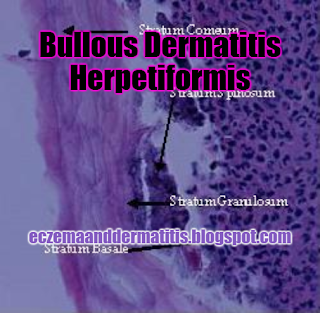When sufferers from bullous dermatitis herpetiformis attempt to understand exactly what disease they have, they face an uphill struggle distinguishing their symptoms from those of celiac dermatitis herpetiformis. It is an unfortunate fact that these two complaints resemble each other in their effects even when the ultimate causes are quite different.
Dermatitis herpetiformis is a skin complaint that is known to be caused by intolerance of gluten in victims’ regular day to day diets. Although the skin eruptions associated with this disease are quite itchy and very unsightly in appearance, it has been shown time and time again that eliminating gluten from one’s day to day food supply eventually leads to the disappearance of the associated skin problems. On the other hand, bullous dermatitis herpetiformis is a different matter. Some experts maintain that this complaint, although similar to celiac dermatitis herpetiformis, should be more properly called linear IgA bullous dermatosis. It is no wonder at all that victims of these related skin diseases often become confused as to precisely what disease they are suffering from.
In fact, closer scrutiny of the matter soon establishes that there are two separate kinds of bullous dermatitis herpetiformis. In the first place there is a disease that affects children. This typically develops when youngsters are aged about two to three, but it eventually fades away during the early teenage years. The adult version of the disease is a different kettle of fish: It is an autoimmune disease that is acquired by patients as a result of an adverse response to medication. The culprit in this regard, which is considered to be the agent to blame for this bullous disease, is none other than vancomycin. This is an antibiotic medication that is prescribed by medics as a treatment for serious bacterial infections, which are known to be resistant to other antibiotics like penicillin. While this medication does a grand job of work in treating very serious infections, it is sadly known to be associated with a veritable catalogue of side effects, including bullous dermatitis herpetiformis.
In view of the fact that diagnosing this bullous disease is no easy matter, even for fully accredited medical personnel, it is extremely unwise for members of the public to second guess the nature of any skin disease that hits them. Speculating and assuming, based upon hearsay and tittle tattle is foolish in the extreme. Similarly, spending precious time lapping up the ill-informed twaddle peddled by quack websites achieves precisely nothing.
Without question, diagnosing a bullous skin disease and distinguishing linear IgA bullous dermatosis from celiac dermatitis herpetiformis are tricky jobs best left to the experts. If you think you could be suffering from bullous dermatitis herpetiformis, literally the only option you should ever consider is to seek the advice of a genuine doctor, who can take a good look at all your symptoms, find out your medical history, and then make the correct diagnosis. Without making such a difficult diagnosis, any treatment or change in diet is nothing more than a shot in the dark.
Source: stasisdermatitis.net/bullous-dermatitis-herpetiformis/
Dermatitis herpetiformis is a skin complaint that is known to be caused by intolerance of gluten in victims’ regular day to day diets. Although the skin eruptions associated with this disease are quite itchy and very unsightly in appearance, it has been shown time and time again that eliminating gluten from one’s day to day food supply eventually leads to the disappearance of the associated skin problems. On the other hand, bullous dermatitis herpetiformis is a different matter. Some experts maintain that this complaint, although similar to celiac dermatitis herpetiformis, should be more properly called linear IgA bullous dermatosis. It is no wonder at all that victims of these related skin diseases often become confused as to precisely what disease they are suffering from.
In fact, closer scrutiny of the matter soon establishes that there are two separate kinds of bullous dermatitis herpetiformis. In the first place there is a disease that affects children. This typically develops when youngsters are aged about two to three, but it eventually fades away during the early teenage years. The adult version of the disease is a different kettle of fish: It is an autoimmune disease that is acquired by patients as a result of an adverse response to medication. The culprit in this regard, which is considered to be the agent to blame for this bullous disease, is none other than vancomycin. This is an antibiotic medication that is prescribed by medics as a treatment for serious bacterial infections, which are known to be resistant to other antibiotics like penicillin. While this medication does a grand job of work in treating very serious infections, it is sadly known to be associated with a veritable catalogue of side effects, including bullous dermatitis herpetiformis.
In view of the fact that diagnosing this bullous disease is no easy matter, even for fully accredited medical personnel, it is extremely unwise for members of the public to second guess the nature of any skin disease that hits them. Speculating and assuming, based upon hearsay and tittle tattle is foolish in the extreme. Similarly, spending precious time lapping up the ill-informed twaddle peddled by quack websites achieves precisely nothing.
Without question, diagnosing a bullous skin disease and distinguishing linear IgA bullous dermatosis from celiac dermatitis herpetiformis are tricky jobs best left to the experts. If you think you could be suffering from bullous dermatitis herpetiformis, literally the only option you should ever consider is to seek the advice of a genuine doctor, who can take a good look at all your symptoms, find out your medical history, and then make the correct diagnosis. Without making such a difficult diagnosis, any treatment or change in diet is nothing more than a shot in the dark.
Source: stasisdermatitis.net/bullous-dermatitis-herpetiformis/







0 Comments:
Post a Comment